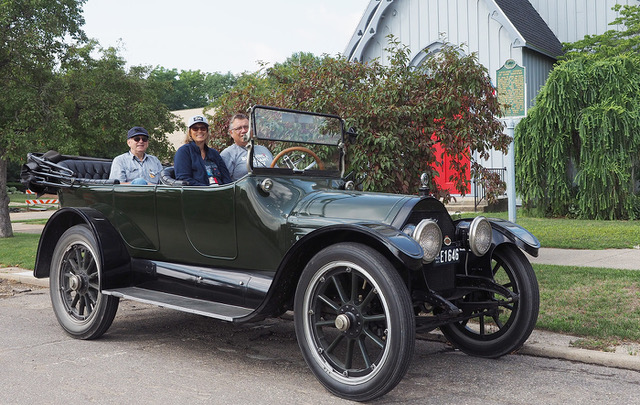
By Gari Voss
Monday, July 17, 2023, the Horseless Carriage Club turned back the hands of time as they travelled the streets of Allegan. This was the second leg of their annual 5-day Celebration of Brass III tour.
The 2023 Tour of the Horseless Carriages began at the Gilmore Car Museum on Friday and Saturday, July 14-15, 2023. This is the one weekend each year that the Gilmore Museum dedicates to the Brass Era cars. On Sunday, the cars toured the Alto and Gun Lake areas. Monday was in Allegan, while Tuesday found the participants traveling to Carlton Park near Hastings.
Dave Stevens, coordinator of the tour, stated, “We like to schedule a short, medium, and long outing each year. Allegan is the medium tour. Drivers come from all over the country, including Canada, to participate.”
Monday began at the Gilmore Car Museum which is their home base. They traversed country roads as much as possible and entered Allegan along M-222/Grand Street to Monroe Street. At the Fire Department, the group divided. Half travelled down Walnut Street toward the Old Jail Museum for a tour. The other half travelled to Cedar Street then around onto Delano before turning down Park to the John Pahl Historic Village on the Allegan Country Fairground.
At noon, all cars gathered in the parking lot of the Silo on M-40 South for a fine lunch. Then the groups exchanged places, with one enjoying the John Pahl Historical Village and the other the Old Jail Museum.
“The group has been active for many, many years,” explained Stevens. “The Horseless Carriage Club started in the 1940s and currently has been renting space at the Gilmore Car Museum.”
The dream has been to establish a Museum of the Horseless Carriage that would feature the Brass Era cars. The Gilmore Car Museum helped put the dream on a path to reality by agreeing to accept the Horseless Museum as a partner museum on their 90-acre parcel of land. In 2020, the Horseless Carriage Club was in possession of their tax exempt 501(c)3 status and a 50-year legal agreement with the Car Museum thanks to financial assistance from the Horseless Carriage Educational Institute.
The Club then began a $3,000,000, 3-year capital campaign to build a 10,000 square foot building, obtain display materials, and purchase some furnishings along with establishing a $1,300,000 endowment to ensure that the Horseless Museum would be viable for the long term.
The Horseless Carriage Club has installed a display featuring a full-size replica of the original Wright Brothers plan that now hangs from the ceiling in Gilmore’s Steam Barn. The viewing can be done from a balcony above the display. Thanks to a group of cars on loan, the Club has also created a display that demonstrates the development of the automobile.
The July Tour is the Club’s annual national signature event at the museum. As they shared, “The first event, A Celebration of Brass@The Gilmore, took place in July of 2021 and was a great success. There is a video featuring the highlights of that event. The two-day celebration at the Gilmore was followed by three magnificent days of touring through the Michigan countryside. A similar event will happen every July.”
“The plan was to raise enough funds to break ground for the new building this year,” explained Stevens. “That did not happen, but we hope to reach our goal sooner than the Lincoln Museum which took seven years.”
The Club has gathered estimates for the new museum building. The dream will come to fruition with financial support from the Horseless Carriage community and others who love the history of the automobile. Anyone wishing to donate can send a check payable to the Museum of the Horseless Carriage, and mail it to the Museum of the Horseless Carriage, Gilmore Car Museum, 6865 West Hickory Road, Hickory Corners, MI 49060.
A Brief History
A brief history of the automobile begins with the primitive land vehicle sketched by Leonardo da Vinci in 1478, then the self-propelled 3-wheeled land vehicle of Nicholas-Joseph Cugnot’s Fardier à vapeur, then the steam power that includes Oliver Evans of Philadelphia in 1805, and ends with the 1886 Benz Paten-Motorwagen.
By 1887, the Experimental Age begins which highlights many European engineers who successfully produced multiple Benz Victoria, Peugeot, De Dion-Bouton, Panhard, Daimler and others European models. During this era, Charles and J. Frank Duryea began production of the first successful gas-engine vehicle in the United States in 1895, while Henry Ford experimented with the first prototype of the Quadricycle.
1899 begins the Brighton Era, named for the Brighton Veteran Car Run in London, that showed growth in the automobile industry mostly for social status around the world. The one- or two-cylinder engines were increasing to four cylinders, but Europe still dominated the industry. The 1896 Brighton Veteran Run in London included only cars built before 1905 and celebrated the lifting of strict rules and speed limits on land vehicles in the UK.
By 1905, cars were becoming bigger and better. The 4-cylinder engine was standard with the leading producer Oldsmobile being replaced by Ford-made vehicles. Cadillac won awards in 1908, and U.S. automobiles were winning races. Because of the use of brass trim, the term Brass Era became popular.
From 1912-1916, the Modern Age of the Horseless Carriage came to be. Engines became larger and Packard even produced a V-12 in 1915. The closed body included front doors. Automobiles became more reliable, had more power and were easier to operate. As nickel and other medals replaced brass, the Brass Era ended.
For more information on the Brass Era vehicles and the Horseless Carriage Club, and to check out their progress toward reaching the monetary goals to construct the Museum of the Horseless Carriage at the Gilmore Car Museum, go to https://www.museumofthehorselesscarriage.org/visit/.
